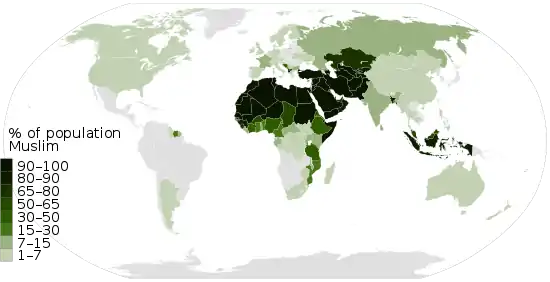Shia Islam in Yemen
Shia Islam in Yemen is practiced by an important minority[1] of the population; estimates that Zaydi Muslims include about 45 percent of the population, Sunnis are 55 percent, and there are also tiny minorities of Muslims who are members of other Shia sects — the Ismaili and Twelver communities.
| Islam by country |
|---|
 |
|
|
The Zaydis ruled Yemen for 1,000 years up until 1962. During this time they ferociously defended their independence and fought off foreign powers (Umayyads, Egypt, the Ottomans) who controlled lower Yemen and tried to extend their rule to the north.[2] The Zaidi branch of Islam, also known as Fivers,is a sect of Islam almost exclusively present in Yemen.[3]
Population
Religion in Yemen consists primarily of two principal Islamic religious groups: 53% of the Muslim population is Sunni and over 45% is Zaidi Shia, according to the UNHCR.[4] Others put the numbers of Shias at 55%.[5][6] Sunnis primarily adhere to the Shafi'i school, and there are also significant followers of the Maliki and Hanbali schools. Shias are primarily Zaidi and also have significant minorities of Twelver[4][7] and Ismaili Shias,[4] on the whole Yemeni shia organize "over half of Yemen's 25 million people".[8]
Zaidis are generally found in the north and northwest and Shafi'is in the south and southeast.[9] There are also approximately 3,000 Christians and 400 Jews.[5]
History
According to historical narrations, Islamic identities in Yemen have been categorized into two main Islamic orientations: Shia Zaydism and Sunni Shafi‘i. Also, small groups of Shia Ismailis and some Jewish communities are seen in the country. The population density of Zaydis historically is placed in the north of Yemen, in Sa’dah, Amran, al-Jawf, Hajjah and Dhamar provinces, as well as Shafiism, is the dominant school of jurisprudence in lower Yemen the eastern part of the country and the Tihamah. However, it can not be said that Zaydies and shafei populations live in Separated regions. For instance, the Sa’dah region, is known as the residents of Zaydism but in some areas, notably al-Hishwah, al-Zahir, Shida and Ghamr, Sunnis make up a considerable part of the population.[10]
The Zaydis belong to a sect of Shia Islam that their generation reaches to eponym Zayd ibn Ali, the great-grandson of Ali Shia first Imam and Zayd ibn Ali rebelled against Umayyad government in 740 CE after death of Husayn ibn Ali at Karbala. As the life of first Zaydi Imam in Yemen, Yahya b. al-Husayn (d.911), he made efforts to establish his rule over the tribes in the north of Yemen.[10]
Houthi movement
According to Charles Schmitz, a professor at Towson University, Houthi's origins reach to Al-Shabab al-Muminin (the Believing Youth), a group that carried out in the early 1990s. The Believing Youth concentrated on raising awareness to the Zaydi branch of Shia Islam, which had ruled Yemen for centuries but after a North Yemen Civil War in the 1960s, they were restrained by the Yemeni government. The claim is supported that they are Yemen's Shia minority containing 35 percent of the country's Muslims.[11]
Similar to Shia Muslims in matters of religious law and rulings, the Houthi belief in the concept of an Imamate as being essential to their religion makes them distinct from Sunnis.[12]
The Houthi movement, which belongs to Yemen's Zaidi Shia Muslim community and fought a series of rebellions against Ali Abdullah Saleh during the last decade, took control of their northern heartland of Saada province and nearby areas.[13]
References
- "Sunnis and Shia in the Middle East". BBC. Retrieved 19 December 2013.
- "Yemen: The conflict in Saada Governorate – analysis". IRIN. 24 July 2008. Retrieved 29 November 2014.
- Al-Shamahi, Abubakr (7 February 2014). "Yemen is more nuanced than 'Sunni' & 'Shia'". Yemen Times. Archived from the original on 2 January 2015.
- "Yemen: The conflict in Saada Governorate – analysis". UN High Commissioner for Refugees. 24 July 2008. Archived from the original on 2012-11-20. Retrieved 2 January 2014.
- Country profile: Yemen. Library of Congress Federal Research Division (August 2008).
 This article incorporates text from this source, which is in the public domain.
This article incorporates text from this source, which is in the public domain. - Merrick, Jane; Sengupta, Kim (20 September 2009). "Yemen: The land with more guns than people". The Independent. London. Retrieved 21 March 2010.
- Al-Zaidi, Hassan (22 October 2007). "The Twelve-Imam Shiite Sect". Yemen Times. Archived from the original on 22 October 2007.
- BASU, TANYA. "Who Are the Houthis?". theatlantic. Retrieved 9 April 2015.
- Background note: Yemen. US Department of State (December 2007).
 This article incorporates text from this source, which is in the public domain.
This article incorporates text from this source, which is in the public domain. - Brandt, Marieke (2017). Tribes and Politics in Yemen: A History of the Houthi Conflict. Oxford University Press. ISBN 978-0190673598. Retrieved 15 November 2017.
- Taylor, Adam. "Who are the Houthis, the group that just toppled Yemen's government?". washingtonpost. Retrieved 22 January 2015.
- Pike, John. "Zaydi Islam". Retrieved 2 September 2014.
- "Yemen crisis: Why is there a war?". BBC. Retrieved 20 November 2018.
